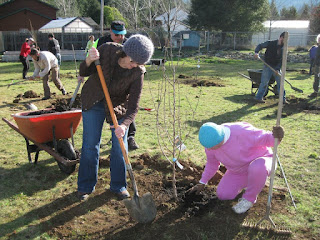The setting lends itself easily to weddings, (and has hosted a wedding in the past) with riverfront views, grassy fields, and a large garden and orchard. Each summer it's my pleasure to grow my own food in the garden, and this summer I'll be growing an array of flowers, in addition to the fruits and vegetables; both will be part of making the place look as vibrant as possible for the coming wedding. The fruit trees and grape vines are no different, and to make sure we have a happy bride, those things needs to be pruned, and soon, to insure they have a proper bloom and set fruit. There's a lot of grunt work to be done, and right now the pruning might be the most crucial.
Home garden with properly pruned fruit trees and grape vines
I've never pruned before. My brother and his fiancee know this. Despite my enthusiasm for having this year be my first attempt at cracking into a new knowledge and skill set, it's understandable that they might be nervous about me doing all the pruning on the property. The last thing I want to do is compromise the setting of their big day by using our orchard as my own personal experimentation zone, and as I've read: "improper pruning has ruined more trees than failure to prune." As best man, I was happy to concede pruning duties to an experienced friend.
But that does not stop me from reading up as much as possible to learn about the process. The upcoming wedding and my own home orchard aren't the only things that have sparked my interest in learning more about pruning. Back in January I helped organize a community effort in Gasquet to get an orchard planted at Mountain School (see our previous blog post: Gasquet Community Orchard), and as I've learned already, fruit trees in their first year need to be taken care of, first and foremost with pruning. I'm just cracking the books and doing my Google research, and I'm getting a firm grasp on the pruning process, in theory, at least for now. As for practice, well, I'm working on getting that, too.
How often do you think a person interested in learning pruning skills has access to an entire orchard, filled with fruit trees that need to be taken care of ASAP, and a job that puts them in contact with a multitude of experts in different agricultural disciplines? This opportunity isn't going to present itself again in my life, so I need to make the most of it. I contacted Deborah Giraud, an agricultural advisor with UC Cooperative Extension in Humboldt, at first to see if she could give me some pointers, and she ended up agreeing to come up to Gasquet to give a first-hand lesson on proper fruit tree care and pruning, and have it be open to anyone with a burgeoning interest in the arboreal arts.
This post will be the first in a 3-part series that will culminate with a post about our Gasquet Orchard Pruning Day, which will be March 27th. Until then, I'm going to hit the books, learn the basics, not go near the wedding fruit trees with anything resembling pruning shears, and hopefully I'll come out the other end as an expert, or at least someone whom a soon-to-be bride can call on to make sure those apple trees are fruit-laden and picturesque for her wedding.




















